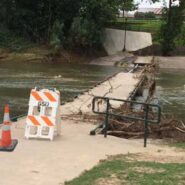Would You Set a Boundary?

At a park I saw a 10 or 11 YO boy climbing around by himself on a partially washed-out concrete footbridge over a creek. The creek was still high and fast-flowing, though not raging the way it had been just a week before when we’d experienced torrential rains and record flooding.
The boy was balancing on the exposed girders where the concrete was missing and poking under the remaining concrete with bamboo pole. An adult couple was silently watching from the bank. When I approached, they said he had seen a water moccasin, then they returned to silent watching.
Being ready to help is an important step to take, and sometimes it’s enough. They were certainly hoping it would be, but in this case, it wasn’t enough for me.
I know that for many people, setting a boundary for the boy would have felt like interfering with someone else’s child. But what they don’t realize is that unsupervised children unconsciously look to the adults around them for permission. If we don’t say anything, they figure it must be OK.
To say the least, playing on a washed out footbridge poking at a dangerous snake was not OK with me!
I’d seen a bike at end of the bridge and thought the boy might have been there on his own, but thought I’d check. When I asked the adult couple if he was with them, they said no.
That was it! I headed out to talk to him. Of course I had no idea what I was going to say other than stating my boundary, but that’s actually the best way to start.
Trusting that “what to say” will come from observing the child makes the first step easy to take.
By now he was seated on the concrete near the missing section and whittling a stick with his pocket knife, so I started with observation and SAY WHAT YOU SEE (SWYS):
SWYS: “Hi! Looks like you’re whittling.”
Boy: (Nodded.)
SWYS: “I heard you saw a snake.”
Boy: “It was a water moccasin. It went under there.” (He pointed to the area under the bridge he’d been poking.)
STRENGTH: “You’re not afraid of it.”
Boy: “No.” (Smiled and kept whittling.)
SWYS: “I also saw you climbing out on those girders.”
STRENGTH: “You weren’t afraid of the water either. You know you can balance.”
Boy: (Smiled and nodded.)
Boundary/CAN DO: “And it’s not OK with me that you are out here. You can go back behind the barricade and explore the river from over there.” (I pointed to the bank of the creek.)
Boy: (Folded his pocket knife, got up and walked with me toward the end of the footbridge, past the wet bamboo pole.)
CAN DO: “That’s the pole you were using. You can take it if you want.”
Boy: (Shook his head.)
SWYS: “You’re done with it.”
Boy: (Nodded.)
As we walked off the footbridge he seemed in good spirits. I asked him to tell me what he knew about the flood, and he happily complied
In Language of Listening® terms:
- I started with SAY WHAT YOU SEE (SWYS) to let him know I cared about what he wanted and understood why he might think it was OK. That met his need for connection.
- I added STRENGTHs and listened to what he knew to meet his need for power.
- I set my boundary and offered CAN DOs to meet his need for experience (though it turned out he was done).
That’s why it was no surprise to me that by the time we reached the barricade we were able to part on friendly terms – him with no resentment and me with peace of mind.
Would you set a boundary for this boy?





